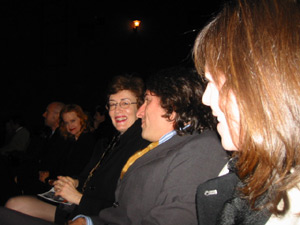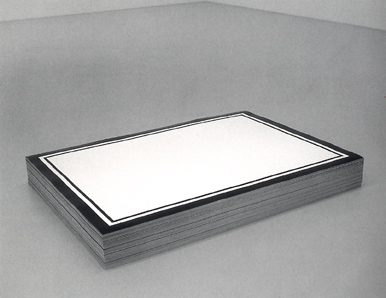Yes, I was glad to see you, and that was a Bible in my pocket. As I tee up to write what appears below, I just realized my schedule yesterday (aka the Sabbath)–church in the morning to the Armory Show (similarities to Gilligan’s Island: began as 3-hour tour, saves self with pleasantly endless supply of special guest stars) to a friend’s dinner for a visiting artist–and my increasing revulsion at politicians’ Christian justification for war, left me toting the Good (but not tiny) Book around all day, and unselfconsciously reading on the train about “blessed are the peacemakers,” “wars and rumours of wars,” and the end of the world as we know it.
I remember being advised, soon after moving to NYC in 1990, that reading the NY Times or the WSJ on the train was a surefire invitation to be mugged. And The Wall St. Journal? Forget about it. The only way to protect yourself, I was told, is to be a less attractive target than other passengers: you can either talk loudly to yourself (i.e., act insane, and thus, unpredictable, possibly dangerous, not worth the hassle) or read the Bible. It’s the pickpocketing equivalent of The Club, self-centered public religiosity that really says, “mug my neighbor.” What would Jesus do, indeed.
WWJD? How about WWGWBD? Bob Woodward in Hendrik Hertzberg‘s New Yorker commentary: “‘[Bush’s] instincts are almost his second religion.’ And if the commandment of his first religion is peace, that of his second, it seems clearer than ever, is war.” Not so fast. Bush’s flavor of Christianity has little to do with the Bible (King James Study Bible , Amazon sales rank: 3,598), and everything to do with Left Behind (Armageddon: The Cosmic Battle of the Ages vol. 11, Amazon sales rank: 67).
With over 50 million copies in print, the Left Behind series is the Harry Potter of the Apocalypse, (If God doesn’t call the authors home soon, there’ll be 12 books total; never seen onr on the subway, though). It the end of the world as its authors (Tim Lahaye and Jerry Jenkins, evangelical ministers/ex-political aides/anointers of John Ashcroft) know it. After millions of True Believers are suddenly caught up in The Rapture, the world stops slouching toward Gomorrah and starts lurching toward Armageddon. Plagues and war ravage the unbelieving earth. After a feckless Democratic president sells the US out to international organizations (it’s not one of heaven’s mysteries that the series began during Clinton’s tenure), the Anti-Christ steps in, seduces shocked citizens with pleas of global tolerance, uses the UN to establish world government, and settles down to rule and reign. From Bahghdad. Oh, and before the world ends, Israel gets all the land it wants. Oh, and the Jews convert to Christianity, etc. etc.
Articles appeared last year (in Salon and the Guardian, for example) after Left Behind took over the NYTimes bestseller list, causing lamentation in the mainstream publishing houses, and Infidels.org (you have been warned) got ready for Y2K with a veritable Baskin-Robbins (31+ flavors) of End Time culture. But as Zachary Karabell writes in last week’s LA Times, “The response of some in the U.S. government to the crises of the last year and a half feels ripped from the pages of the Left Behind books.” If Bush were a straphanger, he’d be doubled down, flaunting the Bible and acting insane, thinking he’s safe (yet somehow unaware that all the other passengers are nervously switching cars).
Frankly, Left Behind strikes me as gratuitous vengeance porn, designed to feed the smugness and self-satisfaction of “Christian” readers, who want to have their cake (their own seat on the Rapture train) and eat it, too (the details of their critics’ impending, gruesome suffering). Is Bush taking his war script from the Gospel according to Left Behind? Is he gonna have a lot more to answer for than he thinks? Is the Pope Catholic?

 A NYT article about
A NYT article about 






